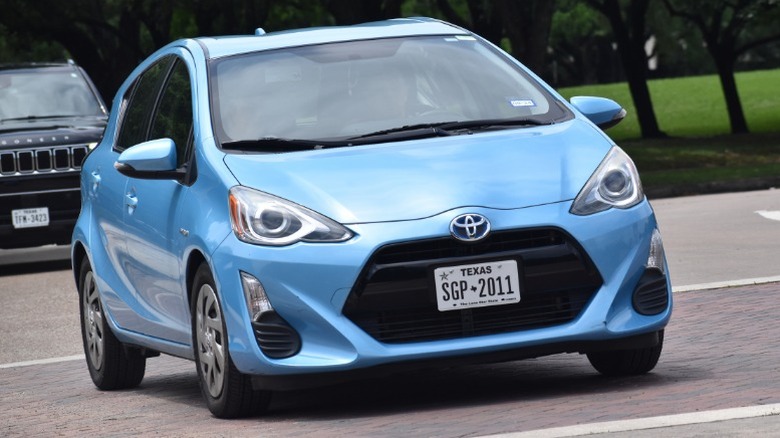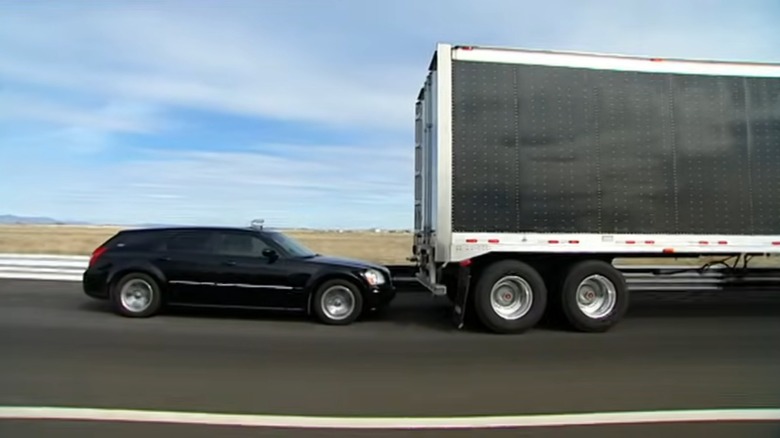Hypermiling Can Get You More Gas Mileage, But It's Not Worth The Risk
Despite the numerous benefits that cars provide, one of the long-term downsides of our vehicles has always been their excessive fuel consumption. Internal combustion engines, like those found in the majority of passenger cars and trucks, rely on a fossil fuel source for power. Not only is the burning of fossil fuels horrendous for our environment, but it's also hard on your wallet. Gas and diesel are expensive, and if you drive a particularly thirsty vehicle, you probably spend more time at the fuel pump than you'd like.
Modern cars are increasingly fuel efficient, thanks to advancements in engine building, as well as the introduction and widespread adoption of emissions control systems, and hybrid and electric vehicles are on the rise. However, fuel continues to be a financial burden for many. That can be especially true for those unable to afford a newer, eco-friendly vehicle and those who rely on their fossil fuel cars for long commutes or who regularly travel in stop-and-go traffic. Just as the destructive nature and high cost of fossil fuels has led to innovation in the field of cleaner energy, it has also led to the development of methods used to increase fuel efficiency in older vehicles that continue to use gas and diesel.
One of the most interesting of those methods is known as hypermiling. In the face of rising fuel costs, hypermiling gained popularity in the early 2000s and includes techniques like selective braking, taking advantage of a larger vehicle's slipstream, and shifting into neutral to coast instead of applying the gas. Hypermiling can result in an increase in fuel mileage. However, many hypermiling techniques are also incredibly dangerous. If you're interested in learning more about hypermiling and why it's not worth the risk, stick around.
What is hypermiling, and how does it improve gas mileage?
Hypermiling is a set of driving techniques that some enthusiasts employ to get the maximum gas mileage possible out of their cars. While there is no specific vehicle designed for hypermiling, it's common for users to drive hybrids, like the Toyota Prius. When executed properly, hypermiling techniques can allow hybrid divers to get upwards of 100 mpg.
Hypermiling is somewhat of a broad term, and it can encompass a large number of different driving techniques and behaviors. However, some of the most common methods utilized in hypermiling circles involve things like using the throttle minimally, selective and smooth braking, parking based on geography and weather, and more. For example, a hypermiling enthusiast may endeavor to park on a downward facing slope, allowing them to coast instead of using the gas pedal to take off from a stop. Other techniques include things as simple as following safe driving practices, like using the throttle gently, avoiding rapid stops and starts, and driving during less traffic-heavy hours.
Other, more extreme hypermiling techniques also exist. For example, some adherents follow a method known as "ridge riding," which involves driving with the two passenger tires on the white barrier line of a highway. In theory, this saves fuel because the tires generate less friction moving across a painted line than they do on the bare pavement. Some other examples of more radical forms of hypermiling involve killing the engine or shifting into neutral to coast and drafting or driving within a larger vehicle's slipstream to prevent drops in fuel mileage caused by wind resistance.
Why is hypermiling dangerous?
While hypermiling can result in substantial increases to fuel efficiency if performed correctly, it can also be extremely dangerous. That doesn't mean that all forms of hypermiling are inherently unsafe. However, many of the more radical methods, especially those employed by enthusiasts looking to set records, can be wildly hazardous.
Of those unsafe techniques, some of the most dangerous include drafting, killing the engine in order to coast, and ridge riding. Drafting or using a larger vehicle's slipstream to decrease wind resistance can provide marginal increases in fuel mileage. However, it's also extremely unsafe for a couple of reasons. First of all, if you're close enough to a large vehicle, like a semi truck, to be in its slipstream, you're also too close to stop safely in the event of an emergency. At 70 mph, you need roughly 348 total feet of stopping distance, or 23 car lengths, to brake safely. If you're only one or two car lengths behind a large vehicle, and it comes to a sudden stop, the chances of you slamming into their rear end are extremely high. The second reason that drafting is so dangerous is that it doesn't allow you to see much of the road in front of you, making accidents and rear-end collisions much more likely.
Killing the engine in order to coast is also dangerous, as it will most likely result in the loss of power steering. This is unsafe on any road, but it's especially hazardous when navigating curves. Many people choose to turn off the engine while coasting down a hill. However, your vehicle can gain extreme amounts of momentum while coasting, and if a sudden curve appears, and you don't have power steering, you could end up in a devastating accident.


